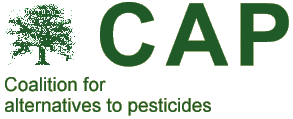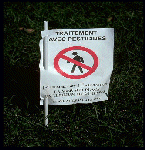
|
|
|
| Home |
| Action Plan |
| Services |
| InfoCAP |
|
Questions
»FAQ »Test |
| Alternatives |
| Moratorium |
|
Effects of Pesticides
»Environment »Health |
| Testimonials |
| Municipal Updates |
| Registration |
| Links |
| Contact us |
|
|

|
|||||||||||||||||||||||||||
|
| 1. WHEREAS | chemical pesticides are inherently toxic products designed to kill various life forms; |
| 2. WHEREAS | reliable ecological, non-toxic methods of pest control exist; |
| 3. WHEREAS | reports published in scientific journals point to strong associations between chemical pesticides and serious health consequences including: birth defects, brain cancer, breast cancer, childhood leukemia, stomach cancer, learning disabilities and non-Hodgkin's lymphoma; |
| 4. WHEREAS | the U.S. National Cancer Institute published a report highlighting the role of pesticides in cancer causation; |
| 5. WHEREAS | approximately 80 percent of all Canadians live and work in (sub) urban areas which allow cosmetic use of pesticides; |
| 6. WHEREAS | homeowners and the chemical lawn care industry use products that have never been adequately tested or monitored for their chronic, synergistic (in-combination) and other effects on human and animal health in residential areas where young children, pregnant women, elderly and other susceptible Canadians are exposed to pesticides; |
| 7. WHEREAS | many of the "safety tests" used to test these products are fundamentally inadequate; |
| 8. WHEREAS | Canada's Minister of Health is charged with "the promotion or preservation of the health ...of the people of Canada"; |
| 9. WHEREAS | the health risks of chemical pesticide use are of growing concern to the Canadian public; |
We demand that the Federal Government impose an immediate moratorium on the use of pesticides for cosmetic purposes until such time as their use has been scientifically proven safe and the long-term consequences of their application are known.
Back to top
 References
References
- Czeizel, AE et al. Environmental trichlorfon and cluster of congenital abnormalities. The Lancet, Vol. 341, Feb. 27, 1993: 539-542
- National Cancer Advisory Board (1994) Cancer at a Crossroads: A Report to Congress for the Nation. National Cancer Institute, Bethesda, Maryland. (See"Environmental and Genetic factors in Carcinogenesis" page B-15.)
- National Cancer Advisory Board (1994) Cancer at a Crossroads: A Report to Congress for the Nation. National Cancer Institute, Bethesda, Maryland. (Voir "Environmental and Genetic factors in Carcinogenesis" page B-12.)
- Lowengart, RA et al. Childhood leukemia and parents' occupational and home exposures. Journal of the National Cancer Institute, Vol. 79, No. 1, July 1987: 39-46
- Newman, P. Cancer clusters among children: the implications of McFarland. Journal of Pesticide Reform, Vol. 9, No. 3, 1989:10-14
- The politics of cancer: why the medical establishment blames victims instead of carcinogens. Utne Reader, Nov/Dec 1993:81-92
- National Cancer Advisory Board (1994) Cancer at a Crossroads: A Report to Congress for the Nation. National Cancer Institute, Bethesda, Maryland. (Voir "Environmental and Genetic factors in Carcinogenesis" page B-14.)
- O'Brien, M. Are pesticides taking away the ability of our children to learn? Journal of Pesticide Reform, Vol. 10, No. 4, Winter 1990/91:4-8
- Hoar, SK et al. 1986. Agriculture herbicide use and risk of lymphoma and soft tissue sarcoma. Journal of the American Medical Association, Vol. 256, No. 9, 1986:1141-1147.
- Wigle, DT et al. Mortality study of Canadian male farm operators: Non-Hodgkin's Lymphoma mortality and agricultural practices in Saskatchewan. Journal of the National Cancer Institute, Vol. 82, No. 7, 1990: 575-582
- Hoar Zahm, S et al. A case-control study of Non-Hodgkin's Lymphoma and the herbicide 2,4-D in Eastern Nebraska. Epidemiology, Vol. 1, No. 5, 1990:349-356
- Hoar Zahm, S & A. Blair. Pesticides and Non-Hodgkin's Lymphoma. Cancer Research (Suppl.), 52, 1992: 5485s-5488s.
- National Cancer Advisory Board (1994) Cancer at a Crossroads: A Report to Congress for the Nation. National Cancer Institute, Bethesda, Maryland. (Voir "Environmental and Genetic factors in Carcinogenesis" page B-15.)
- Hayes, HM et al. Case-control study of canine malignant lymphoma: positive association with dog owner's use of 2,4-D herbicides. Journal of the National Cancer Institute, Vol. 83, No. 17, 1991: 1226-1231.
- Scarborough, ME et al. Acute health effects of community exposure to cotton defoliants. Archives of Environmental Health, Vol. 44, No. 6, 1989: 355-360.
- Subcommittee to Evaluate the National Cancer Program (1994) Cancer at a Crossroads: A Report to Congress for the Nation. National Cancer Advisory Board of the National Cancer Institute. Bethesda. Voyez surtout le tableau sur les facteurs g´┐Żn´┐Żtiques et environnementaux dans l'appendice B (pages B12-B15). (pg. 21). (Tel: (301) 496-5515 pour des copies de ce rapport) . Veuillez noter ´┐Żgalement que la Soci´┐Żt´┐Ż Nationale du Cancer a r´┐Żuni un comit´┐Ż de travail en mai 1994 pour ´┐Żtudier les relations entre le cancer et les pesticides. Ce rapport demande qu'il y ait plus de recherche et d'´┐Żducation sur ce sujet et recommande de "changer les lois, les r´┐Żglements et les pratiques, incluant celles qui sont reli´┐Żes ´┐Ż l'environnement et ´┐Ż l'alimentation, qui contribuent ´┐Ż la probl´┐Żmatique du cancer et qui an´┐Żantissent les efforts de pr´┐Żvention et de contr´┐Żle."
- Koppell, G.O. (1994) Toxic Fairways: risking groundwater contamination from pesticides on Long Island golf courses. New York State Department of Law, New York. Dans ce rapport, l'Avocat G´┐Żn´┐Żral ´┐Żtablit que les fermiers utilisent 1,5 lbs de pesticides par acre et par ann´┐Że, et 2,7 lbs par acre trait´┐Ż (car toutes les terres agricoles ne sont pas trait´┐Żes chaque ann´┐Że). Pour les terrains de golf, les valeurs sont de 7 lbs et 18 lbs. Quant aux terrains r´┐Żsidentiels, ils re´┐Żoivent de 3 ´┐Ż 10 lbs de pesticides par acre et par ann´┐Że!
- Les pesticides sont ´┐Żvalu´┐Żs pour leurs effets aigus (pas chroniques), d'un seul produit ´┐Ż la fois (et non plusieurs) sur des animaux (pas des ´┐Żtres humains) adultes (pas des f´┐Żtus ou des jeunes enfants) en sant´┐Ż (pas malades, hypersensibles ou dont le syst´┐Żme immunitaire est affaibli) et sur de courtes p´┐Żriodes (et non pas ´┐Ż long terme)´┐Ż
Back to top
© 2000 Coalition for Alternatives to Pesticides
Webmaster: Shawn Buzzell
|
|

|

|